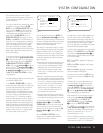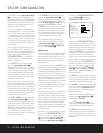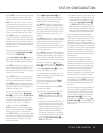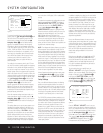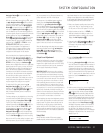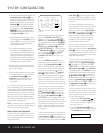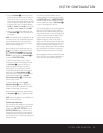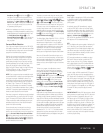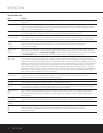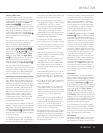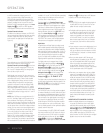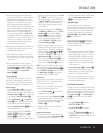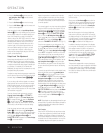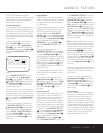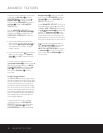
OPERATION 31OPERATION 31
OPERATION
Headphone Jack G behind the door @ on the
front panel. The speakers will automatically mute
and a two-channel stereo signal will be sent to the
headphones. The
Lower Display Line & will read
DOLBY H: BP, indicating that the headphone
output is in the Bypass mode, and to confirm that
no processing is being used.
• When the headphones are in use, you may take
advantage of the Dolby Headphone modes to bring
added spaciousness to headphone listening. Press
the
Dolby Mode Select Button g or the
Surround Mode Selector 4 to cycle through the
three Dolby Headphone modes to select the one
that you prefer.
Surround Mode Selection
One of the most important features of the DPR 2005
is its ability to reproduce a full multichannel sound field
from digital sources, analog matrix surround-encoded
programs and standard stereo programs.
Selection of a surround mode is based on personal
taste, as well as the type of program source material
being used. For example, motion pictures or TV pro-
grams bearing the logo of one of the major surround-
encoding processes, such as Dolby Surround or DTS
Stereo may be played in either the Dolby Digital,
Dolby Pro Logic II Cinema, Dolby Pro Logic IIx Cinema,
DTS Neo:6 Cinema, or Logic 7 Cinema surround
modes, depending on the source material.
NOTE: Once a program has been encoded with matrix
surround information, it retains the surround information
as long as the program is available in stereo. Thus,
movies with surround sound may be decoded via any
of the analog surround modes such as Pro Logic II or
IIx Cinema, Logic 7 Cinema or DTS Neo:6 Cinema,
when they are broadcast via conventional TV stations,
cable, pay-TV and satellite transmission. Also, a growing
number of TV programs, sports broadcasts and radio
dramas are also recorded in surround sound.
Even when a program is not listed as carrying intentional
surround information, you may find that the Pro Logic II,
Logic 7 Enhanced or DTS Neo:6, VMAx and the Hall or
Theater modes often deliver enveloping surround pre-
sentations through the use of the natural information
present in all stereo recordings.
Surround modes may be changed at any time by
using either the front panel or remote control. To
select a new surround mode from the front panel, first
press the
Surround Mode Group Selector Button
3 until the desired major surround mode group such
as Dolby, DTS or Logic 7 is selected. Next, press the
Surround Mode Selector Button 4 to choose the
specific individual surround mode.
To select a surround mode using the remote, press
the button for the surround mode group that includes
the mode you wish to choose:
Dolby g, DTS
Digital
f, DTS Neo:6 e, Logic 7 h, Stereo
d or DSP Surround g. The first press of the
button will show the current mode from that group if it
is already in use, or the first available mode if you are
currently using another mode. To cycle through the
available modes in that group, press the button again
until the desired mode appears in the
Lower Display
Line
&, the on-screen display and in the front-panel
Surround Mode Indicators *.
The Dolby Digital, Dolby Digital EX, DTS 5.1, DTS-ES
Matrix and DTS-ES Discrete modes may only be
selected when a digital input is in use. In addition,
when a digital source is present, the DPR 2005 will
automatically select and switch to the correct mode,
regardless of the mode that has been previously
selected. For more information on selecting digital
sources, see the Digital Audio Playback section below.
When the 6-Channel/8-Channel direct inputs are in
use, there is no surround processing, as these inputs
take the analog output signals from an optional, exter-
nal DVD-Audio or SACD player, or another source
device, and carry them straight through to the volume
control.
To listen to a program in traditional two-channel
stereo, using the front left and front right speakers
only (plus the subwoofer, if installed and configured),
press the
Stereo Mode Select Button until
SURROUND
OFF appears in the Lower Display
Line
&.From the front panel, press the Surround
Mode Group Selector
3 until the Stereo
modes
appear in the on-screen display and
Lower Display
Line
&. Next, press the Surround Mode Selector
Button
4 until SURROUND OFF appears in
the on-screen display and
Lower Display Line &.
Digital Audio Playback
Digital audio is a major advancement over analog sur-
round processing systems. It delivers up to six discrete
channels, and each channel reproduces full frequency
range (20Hz to 20kHz) and offers dramatically improved
dynamic range and significant improvements to signal-
to-noise ratios. In addition, digital systems have the capa-
bility to deliver an additional channel that is specifically
devoted to low-frequency information. This is the “.1”
channel referred to when you see these systems
described as “5.1,” “6.1” or “7.1.” The bass channel is
separate from the other channels, but since it is inten-
tionally bandwidth-limited, sound designers have given it
that unique designation.
Dolby Digital
Dolby Digital is a standard part of DVD, and is available
on specially encoded LD discs and satellite broad-
casts and it is a part of the high-definition television
(HDTV) system.
An optional, external RF demodulator is required
to use the DPR 2005 to listen to the Dolby Digital
soundtracks available on laser discs. Connect the RF
output of the LD player to the demodulator and then
connect the digital output of the demodulator to the
Optical or Coaxial Inputs fl‡HJ of the
DPR 2005. No demodulator is required for use with
DVD players or DTS-encoded laser discs.
DTS
DTS is a digital audio system capable of delivering 5.1
or 6.1 discrete or matrix sound field reproduction.
Although both DTS and Dolby Digital are digital, they
use different methods of encoding the signals, and
thus they require different decoding circuits to convert
the digital signals back to analog.
DTS-encoded soundtracks are available on select
DVD and LD discs, as well as on audio-only DTS
discs. You may use any LD or CD player equipped
with a digital output to play DTS-encoded discs with
the DPR 2005. All that is required is to connect the
player’s output to either an
Optical or Coaxial Input
on the rear panel fl‡ or front panel HJ.
In order to listen to DVDs encoded with DTS sound-
tracks, the DVD player must be compatible with the
DTS signal, which is indicated by the “DTS Digital Out”
logo on the player’s front panel. Some early DVD play-
ers were not able to play DTS-encoded DVDs. This
does not indicate a problem with the DPR 2005, as
those players cannot pass through the DTS signal. If
you’re in doubt as to the capability of your DVD player
to handle DTS discs, consult the player’s owner’s
manual.
IMPORTANT NOTE: Many DVD players have a default
setting that does not pass through the DTS data, even
though the machine is capable of doing so. If your
DVD player has the “DTS Digital Out” logo but does
not trigger DTS playback in the DPR 2005, change
the player’s settings in the “Audio” or “Bitstream” con-
figuration menu so that DTS playback is enabled. The
method for doing this will vary with each player. In
some cases, the proper menu choice will be “Original,”
while in others it will be “DTS.” Consult the owner’s
manual for your player to find the specific information
to find the proper setting.
40



